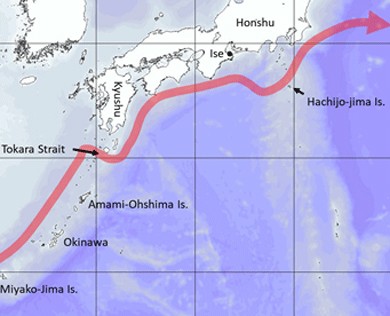The Kuroshio Current, often called the “Black Stream,” is a colossal river of warm water flowing through the Pacific Ocean. It’s a western boundary current, similar to the Gulf Stream in the Atlantic, and plays a vital role in regional and global climate patterns, marine ecosystems, and even human societies. Understanding its characteristics, particularly its speed, is crucial to grasping its far-reaching impacts. But just How Fast Does The Kuroshio Current Move, and what factors influence its dynamic nature?
Decoding the Kuroshio Current: Key Characteristics and Speed
Originating east of the Philippines, the Kuroshio Current embarks on a northeasterly journey, sweeping past Taiwan and Japan. This powerful current forms the western arm of the North Pacific Subtropical Gyre, a vast, clockwise-rotating system of ocean currents. One of the most defining traits of the Kuroshio is its speed. The surface water of this current is known for its rapid movement, a key factor in its ability to transport heat, salt, and various materials across vast distances.
The surface water of the Kuroshio moves rapidly, transporting heat, salt, organic and inorganic matter from south to north.
This swift motion is not just a gentle flow; the Kuroshio Current’s surface waters can reach speeds of approximately two meters per second. To put this into perspective, that’s roughly 7.2 kilometers per hour or about 4.5 miles per hour. This impressive velocity allows it to transport a significant volume of warm, salty water from the tropics towards higher latitudes. The current’s origin in tropical regions is the reason behind its warm and saline nature. It’s fed by the North Equatorial Current, which flows westward and then turns northwards at the western boundary of the Pacific, becoming the Kuroshio.
Path of the Kuroshio Current near Japan, highlighting its trajectory and influence on the region.
The Kuroshio’s speed and warmth are visually striking, particularly in spring. Satellite imagery reveals streaks of warmer water, almost transparent in appearance. This transparency is due to the low concentration of phytoplankton and other marine organisms in its surface waters, which are characteristically nutrient-poor at their origin. This seemingly paradoxical situation – nutrient-poor waters teeming with fish – is known as the “Kuroshio Paradox,” which we will explore further.
The Kuroshio’s Influence on Japan: Weather, Economy, and Culture
The Kuroshio Current’s proximity to the Japanese archipelago has profound effects on various aspects of life in Japan, ranging from weather patterns to economic activities and even cultural traditions.
One of the most direct impacts is on local weather. Ocean surface temperatures play a crucial role in regulating air temperatures. As the Kuroshio transports warmer water northward, it significantly influences the climate of Japan. The heat carried by the current often leads to cloud formation, increasing the likelihood of rainfall and even altering storm paths.
For instance, during winter, a significant meander in the Kuroshio’s path can push low-pressure systems southward near Honshu Island. This shift, in turn, elevates the chances of snowfall in areas like Tokyo, demonstrating the current’s subtle yet powerful control over regional weather.
Beyond weather, the Kuroshio is deeply intertwined with Japan’s economy and society. The nutrient-rich subsurface waters, brought to the surface through upwelling and mixing processes associated with the Kuroshio, support a thriving fishing industry. In a nation where fish is a dietary staple and a primary protein source, the Kuroshio’s bounty is invaluable.
Furthermore, the Kuroshio’s influence extends into the realm of Japanese culture. Various species associated with the Kuroshio, such as Skipjack tuna, lobster, and turban shell, hold cultural significance and are featured in traditional ceremonies at shrines, highlighting the deep connection between the current and Japanese heritage.
However, the Kuroshio is not a static entity. Interannual variability in its behavior leads to fluctuations in nutrient transport, subsequently affecting biological productivity and the fisheries it supports. The underlying mechanisms driving these variations and their cascading effects are still subjects of ongoing research.
Unraveling the Kuroshio Paradox: Life in Nutrient-Poor Waters
The “Kuroshio Paradox” refers to the seemingly contradictory phenomenon of rich fish populations thriving in the Kuroshio Current’s surface waters, which are known to be nutrient-poor. For ocean scientists, this has been a captivating puzzle. The solution, it turns out, lies beneath the surface.
Recent studies show that the Kuroshio transports a large amount of nutrients in dark subsurface layers from south to north as a nutrient stream.
While the surface waters may lack nutrients, the Kuroshio acts as a conduit for nutrient-rich subsurface layers. These deeper waters are transported northward, effectively creating an underwater nutrient stream. South of Honshu Island, the Kuroshio’s dynamics often draw these nutrient-rich subsurface waters towards the coast. This upwelling process brings not only warmer surface waters but also these deeper, nutrient-laden layers closer to land, fueling biological productivity in coastal regions and supporting the food web that sustains fish populations.
Possible spawning migrations of Notoscopelus japonicus in relation to oceanic fronts in the western North Pacific, illustrating the complex interplay between marine life and oceanographic features.
Kuroshio’s Role in Climate Regulation: A Major Carbon Sink
The Kuroshio Current’s impact extends beyond regional weather and marine life; it also plays a significant role in global climate regulation, particularly as a major carbon dioxide sink.
The Kuroshio Extension is one of the major net carbon dioxide sinks for the Earth’s atmosphere.
The region downstream of the Kuroshio, known as the Kuroshio Extension, located east of Honshu Island, is recognized as a significant area for carbon dioxide absorption from the atmosphere. Similar to the Gulf Stream Extension in the North Atlantic, this “carbon hotspot” effectively removes CO2 from the atmosphere and sequesters it in the deep ocean.
Researchers are actively investigating the reasons behind the exceptional CO2 absorption capacity of the Kuroshio Extension and the Gulf Stream Extension. One contributing factor is the cooling of warm waters as they move northward. Colder water has a greater capacity to dissolve and absorb CO2.
Another crucial aspect is phytoplankton photosynthesis. These microscopic marine plants utilize CO2 during photosynthesis, drawing it down from the surface waters. The interplay between temperature changes, biological activity, and ocean dynamics contributes to the Kuroshio Extension’s role as a vital carbon sink.
Understanding the Kuroshio’s nutrient stream and its influence on CO2 absorption is crucial for predicting future ocean responses and feedbacks to climate variability. Further research is essential to fully elucidate these complex processes.
Challenges in Studying the Kuroshio: Scales of Space and Time
Studying the Kuroshio Current presents significant challenges due to the vast range of spatial and temporal scales at which its dynamic processes operate.
The greatest challenge is to accommodate varieties of scale, all of which are required for a comprehensive understanding of the physical, biogeochemical and ecosystem dynamics of the Kuroshio.
Researchers must consider phenomena occurring across ocean basin scales of thousands of kilometers, where the current exhibits decadal-scale variations influenced by atmospheric changes. They also need to investigate eddies, swirling masses of water spanning hundreds of kilometers, which emerge from the Kuroshio on weekly to monthly timescales.
Furthermore, ocean fronts, boundaries between water masses, can break down into smaller flows at scales of hundreds to tens of meters, with dynamics unfolding in days. These intricate features interact with subsurface ocean waves and trigger microscale turbulence at even finer scales, down to millimeters and occurring in seconds to minutes.
Oceanographic research being conducted in the northwestern Pacific, highlighting the efforts to understand the complex dynamics of the Kuroshio Current.
A comprehensive understanding of the Kuroshio demands the ability to resolve all these scales simultaneously, both in observational studies and numerical simulations. However, current technology and methodologies are still striving to achieve this holistic view.
Conclusion: The Enduring Enigma of the Kuroshio Current
The Kuroshio Current, with its remarkable speed and complex interactions with the environment, remains a fascinating and vital area of oceanographic research. From its influence on Japanese weather and ecosystems to its role as a major carbon sink, the Kuroshio’s impacts are far-reaching and globally significant. While significant progress has been made, many mysteries still surround this “artery of life.” The intricate dynamics of the Kuroshio Current, spanning vast scales of space and time, will undoubtedly keep scientists engaged for many years to come, seeking to unravel its secrets and better understand its role in our planet’s interconnected systems.

